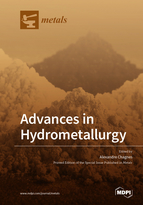Advances in Hydrometallurgy
A special issue of Metals (ISSN 2075-4701). This special issue belongs to the section "Extractive Metallurgy".
Deadline for manuscript submissions: closed (30 September 2018) | Viewed by 85207
Special Issue Editor
Interests: hydrometallurgy; lithium-ion battery; solvent extraction; recycling; circular economy
Special Issues, Collections and Topics in MDPI journals
Special Issue Information
Dear Colleagues,
The development of new technologies and the increasing demand of mineral resources from emerging countries are responsible for significant tensions in the price of non-ferrous metals. Some metals have become strategic and critical because they are used in many technological applications and their availability remains limited. In addition to energetic raw materials, such as oil or gas, the industry uses about fifty different metals. For many of them, the worldwide annual consumption ranges from a few tens of tons to several hundred thousand tons. Some of them, the so-called strategic metals, are crucial for achieving high performances. They are found in high-tech products, such as flat panel TVs (indium), solar panel cells (indium), lithium-ion batteries for electric vehicles (lithium), magnets (rare earths, such as neodymium and dysprosium), scintillators (rare earths), and aviation and medical applications (titanium). The secured supply of these metals is crucial to continue producing and exporting these technologies, and because specific properties of these metals make them essential and difficult to substitute for a given industrial application.
Hydrometallurgical processes have the advantages of being able to process low-grade ores, to allow better control of co-products and to have a lower environmental impact. With the depletion of deposits and the growing interest in low-grade elements (e.g., rare earth elements), the metallurgical industry has shown a growing interest in the development of hydrometallurgical processes more adapted to current challenges over the last fifteen years. The need to develop more efficient, economical and environmentally-friendly processes, capable of extracting metals from increasingly complex and poorly polymetallic matrices, is real. The aim of this Special Issue is to highlight recent advances related to hydrometallurgy to face new challenges in metal production.
Prof. Alexandre Chagnes
Guest Editors
Manuscript Submission Information
Manuscripts should be submitted online at www.mdpi.com by registering and logging in to this website. Once you are registered, click here to go to the submission form. Manuscripts can be submitted until the deadline. All submissions that pass pre-check are peer-reviewed. Accepted papers will be published continuously in the journal (as soon as accepted) and will be listed together on the special issue website. Research articles, review articles as well as short communications are invited. For planned papers, a title and short abstract (about 100 words) can be sent to the Editorial Office for announcement on this website.
Submitted manuscripts should not have been published previously, nor be under consideration for publication elsewhere (except conference proceedings papers). All manuscripts are thoroughly refereed through a single-blind peer-review process. A guide for authors and other relevant information for submission of manuscripts is available on the Instructions for Authors page. Metals is an international peer-reviewed open access monthly journal published by MDPI.
Please visit the Instructions for Authors page before submitting a manuscript. The Article Processing Charge (APC) for publication in this open access journal is 2600 CHF (Swiss Francs). Submitted papers should be well formatted and use good English. Authors may use MDPI's English editing service prior to publication or during author revisions.
Keywords
- Raw material
- Extractive metallurgy
- Hydrometallurgy
- Process
- Strategic metals
- Critical metals
- Recycling
- Physicochemistry






